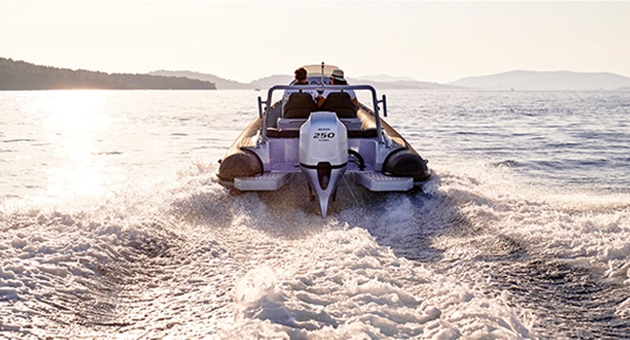Genuine Honda propellers are made specifically for your Honda outboard engine.
It is important to regularly inspect your outboard engine's propeller during boating season to ensure that no debris has become wrapped around the propeller shaft. If the propeller is damaged by striking a rock or other obstacle, it will require replacement.
Visit your authorized Honda Dealer for assistance in choosing the right propeller for your Honda outboard engine.
Why use a Genuine Honda propeller?
Four-stroke marine engines perform at rpm ranges considerably different from two-stroke marine engines. To help achieve optimum performance, it is important to use a propeller designed for four-stroke applications. In addition, Genuine Honda outboard engines utilize a slightly different final-gear ratio in the lower gear case.
Honda propellers are designed with all these factors in mind, to help produce the best possible match for top performance through the entire rpm range.
What's the right propeller for you?
The two most important things to remember when choosing a propeller are: 1. That it meets your individual needs; and 2. That it allows the engine to run within the specified rpm range at full throttle.
Two identical boats with identical engines could be propped quite differently, depending on the usage, water conditions and load.
3-Blade vs. 4-Blade propellers
In general, 3-blade propellers are the most common. They typically yield a slightly higher top-end speed compared to 4-blade propellers, and they are available in a wider variety of designs.
The 4-blade propellers often provide more lift at the stern, which will help accelerate the hull, especially if it is stern heavy. They allow the boat to come out of the hole strong and work well for pulling skiers and water toys.
On fishing and offshore boats, 4-blade propellers can be slightly faster than 3-blade propellers at mid-range rpms, where coastal anglers most often run their outboard engines. They also deliver slightly better fuel economy at mid-range rpm.
Sometimes a poor-handling boat will improve by switching to a 4-blade propeller, and more often than not, a 4-blade propeller will run smoother, with better balance than the 3-blade equivalent.
Choosing the right propeller size
Propellers are sized and described by their diameter and pitch. The pitch ultimately is responsible for the top speed of the boat. The pitch must be matched to the engine's recommended rpm range for full throttle.
For slow-trolling anglers, a propeller with lower pitch (less distance per turn) allows the engine to rev to the top of its range and will offer lower trolling speeds. It will also push loads easier and make maneuvering around a dock smoother.
On the other hand, a propeller with more pitch lets the engine turn to the lower end of its range and may yield a higher top speed.
Matching style, blade design, pitch and diameter are all just as important for boat handling and safety as for maximizing cruising speed and fuel efficiencies.
Large-diameter propellers with lots of surface area help a boat climb a big wave and allow the operator to maintain good control in offshore conditions with rough water.

